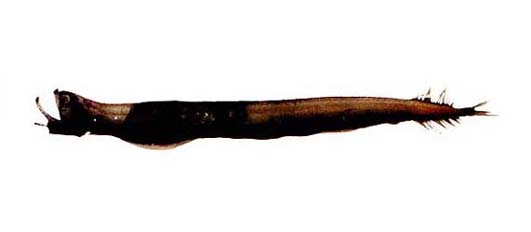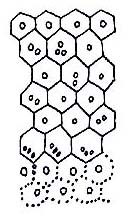ワニトカゲギス科
- HOME
- デジタル図鑑
- パタゴニア海域の重要水族
- 硬骨魚綱 ワニトカゲギス目 ワニトカゲギス科
ワニトカゲギス科(Stomiidae)

19 クロトカゲギス(Kuro-tokagegisu)
Stomias atriventer Garman, 1899
特 徴:
背鰭18軟条,臀鰭20軟条,胸鰭6軟条,腹鰭5軟条,鰓条骨数18。頭長は体長の8.6%,眼径は1.8%,体長は9.1%,吻長は2.5%,両眼間隔は2.3%,上顎長は10.2%,尾柄高は1.7%,胸鰭長は(欠損),腹鰭長は12.4%,背鰭高は6.2%,臀鰭高は5.2%,髭長は13.7%。体は細長く側扁し,体長は体高の約11倍。頭は小さく,体長は頭長の約12倍。吻は短く,頭長は吻長の約3.5倍。両顎はよく発達し,下顎の方がより大きくまた前方に突出する。10本の内側に湾曲した牙状歯(うち3本は他より大)が下顎に,6本の内側に湾曲した牙状歯(うち3本は他より大)が上顎にある。主上顎骨下面に鋸歯縁を有する。顎髭は柔軟で細長く,先端に黒い細長い柄を持った2つの発光球がある。内側に湾曲した牙状歯が鋤骨上に3対,蓋骨上に2対ある。背鰭と臀鰭は両方とも体の後方に位置し,ほぼ対在し尾鰭に接近する。胸鰭は小さく,下位で,鰓蓋後縁直後に位置する。腹鰭も小さく,頭部よりも尾鰭にはるかに近く位置する。体側発光器はよく発達し,配列は胸部前発光器(IP)9,胸部腹側発光器(PV)46,腹部腹側発光器(VAV)12,尾部発光器(AC)13,胸部体側発光器(OV)42,および腹部体側発光器(VAL)13。体側発光器の上方に6列の6角形状鱗状紋が並列し,各々の鱗状紋中に数個の小発光細胞が存在する。鱗は微小で脱落し易い。体は黒褐色か黒色で,各鱗は半透明。
分 布:
チリとカリフォルニア湾の深海中層に分布する。
備 考:
全世界の深海中層域に8種(うち1種は2亜種に分けられる)が知られている(Morrow, 1964)が,種間の差は微妙でさらに詳細な研究が待たれている。
(中村 泉)
Material examined:
1 from Chile (155.1 mm SL), FAKU CP 203.
Description:
D 18; A 20; P1 6; P2 5; BR 18.
HL 8.6% of SL; ED 1.8; BD 9.1; SN 2.5; IO 2.3; UJ 10.2; CP 1.7; P2L 12.4; DH 6.2; AH 5.2; Barbel L 13.7.
Body slender, its length about 11 times of its depth, and very compressed. Head about 12 in SL. Snout very short about 3.5 in HL. Jaws well developed, lower jaw larger and more projected forward than upper jaw. Mouth protractile. Six fang -like teeth curving inward in which three are larger than others on upper jaw and fang-like teeth curving inward in which three are larger on lower jaw. Maxilla with saw-like fine serrations. Mental barbel slender, flexible, its length about 1.8 times of HL. Luminous bulb with two slender black, simple filaments at terminal of barbel. Fang-like teeth curving inward, three pairs on vomer and two on palatine. Dorsal and anal fins placed far posteriorly, close to caudal fin. Pelvic fin base nearer to caudal fin than to head. Pectoral fin placed low on body, immediately behind gill-opening. Luminous organs well developed: IP 9; PV 46; VAV 12; AC 13; OV 42; VAL 13. Photophore pattern on side of body forming six longitudinal rows, each pattern marked by regular small photophres. Body black to dark brown. Fins pale in preserved specimens. Barbel stem pale, one black spot at base of bulb. Bulb pale, filament black.
Distribution:
Bathypelagic waters of Gulf of California and Chile.
Remarks:
Besides the species described in this book, Stomias nebulosus Alock, 1889 from the Pacific and Indian oceans, S. danae Ege, 1933 from the Pacific, S. brevibartus Ege, 1918 from the North Atlantic, S. colubrinus Garman, 1899 from the East Pacific, North Atlantic, and off west coast of Central Africa, and A. affinis Günther, 1887 from circumtropical waters are recognized (Morrow, 1964).
(Izumi NAKAMURA)

Distribution of Stomias atriventer in Patagonia.

Scale and photophore patterns.
- 1
- 2